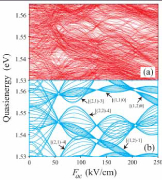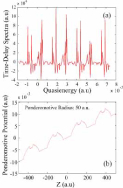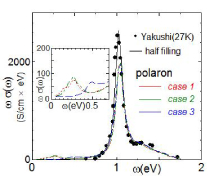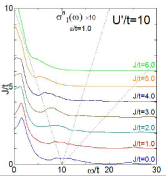Research
1.Interaction between light and semiconductor quantum nanostructures
Floquet states are electronic systems driven by strong CW THz laser form photodressed electron states.
We develop new quantum many-body methods dealing with these photodressed particles as fundamental quasi-particles, and explore new pnotoinduced phenomena.
In particular, we study dynamic correlation and non-equilibrium quantum dynamics induced by correlation effect and
interband photo-excitation of composite particle system (exciton, charged exciton, exciton molecule, etc.).
[K.Hino, X. M. Tong and N. Toshima,“Interacting dynamic Wannier-Stark ladder driven by a periodic pulse train”, Phys. Rev. B 77, 045322_1-19 (2008)]
 |
 |
|---|---|
| Quasienergies of electron-hole joint band of laser-driven semiconductor superlattice(a)with exciton effect(b)without exciton effect. | (a)Time-Delay spectrum and (b)Pondermotive potential energy at Ponderomotive radius 50 (a.u.) of dynamic Wannier-Stark ladder electron. |
2.Photoinduced phase transition in strongly correlated electron system
We study photoinduced phenomena in strongly correlated electron systems listed below.

[N.Maeshima and K.Yonemitsu, “Polaronic States with Spin-Charge-Coupled Excitation in a One-Dimensional Dimerized Mott Insulator K-TCNQ”,J.Phys.Soc. Jpn.77,074713_1-6(2008)]
